| Khonsu called To in hieroglyphs |
|---|
Khonsu called To who was First Prophet of Menkheperre (Thutmose III), during the reign of Ramesses II in the 19th Dynasty [2]
| Khonsu called To in hieroglyphs |
|---|
Khonsu called To who was First Prophet of Menkheperre (Thutmose III), during the reign of Ramesses II in the 19th Dynasty [2]
Khonsu was the son of the High Priest of Amenhotep II Neferhotep and Tawosret. Khonsu had several brothers and sisters including the High Priests of Thutmosis I Nay and Iuy. [2]
Khonsu is attested with two wives in his tomb TT31. His first wife Ruia was the mother of the High Priest of Sobek Usermontu and other children. His second wife May was mother to the Stablemaster Usermontu and the Second Prophet of Menkheperre Khaemwaset and others. [2]
Khonsu served as High Priest of Menkheperre (Thutmose III) and is depicted in his tomb overseeing the transport of a statue of the King. Depictions show a pylon at the Temple of Mencheperre at Armant. Khonsu is shown accompanying a statue of Thutmosis III as it travels up a canal from the Nile to the landing spot at the temple. The pylon depicted is thought to be the VIIth pylon at the Temple of Amun at Karnak. [3]
Khonsu was also the High Priest of Montu at Tod, a location just south of Thebes.

Nefertari, also known as Nefertari Meritmut, was an Egyptian queen and the first of the Great Royal Wives of Ramesses the Great. Nefertari means 'beautiful companion' and Meritmut means 'Beloved of [the goddess] Mut'. She is one of the best known Egyptian queens, next to Cleopatra, Nefertiti, and Hatshepsut. She was highly educated and able to both read and write hieroglyphs, a very rare skill at the time. She used these skills in her diplomatic work, corresponding with other prominent royals of the time. Her lavishly decorated tomb, QV66, is one of the largest and most spectacular in the Valley of the Queens. Ramesses also constructed a temple for her at Abu Simbel next to his colossal monument there.

Heqamaatre Ramesses IV was the third pharaoh of the Twentieth Dynasty of the New Kingdom of Ancient Egypt. His name prior to assuming the crown was Amonhirkhopshef. He was the fifth son of Ramesses III and was appointed to the position of crown prince by the twenty-second year of his father's reign when all four of his elder brothers predeceased him. His promotion to crown prince:
is suggested by his appearance in a scene of the festival of Min at the Ramesses III temple at Karnak, which may have been completed by Year 22 [of his father's reign].

Menkheperre, son of Pharaoh Pinedjem I by wife Duathathor-Henuttawy, was the High Priest of Amun at Thebes in ancient Egypt from 1045 BC to 992 BC and de facto ruler of the south of the country.
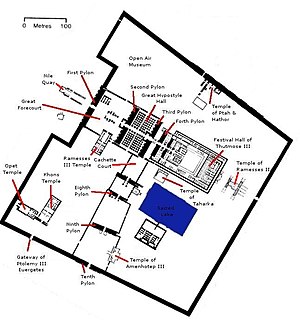
The Precinct of Amun-Re, located near Luxor, Egypt, is one of the four main temple enclosures that make up the immense Karnak Temple Complex. The precinct is by far the largest of these and the only one that is open to the general public. The temple complex is dedicated to the principal god of the Theban Triad, Amun, in the form of Amun-Re.
Prince Khaemweset was the fourth son of Ramesses II, who was born c. 1303 BCE; died July or August 1213 BCE; reigned 1279–1213 BCE, and the second son by his queen Isetnofret. He is by far the best known son of Ramesses II, and his contributions to Egyptian society were remembered for centuries after his death. Khaemweset has been described as "the first Egyptologist" due to his efforts in identifying and restoring historic buildings, tombs and temples.
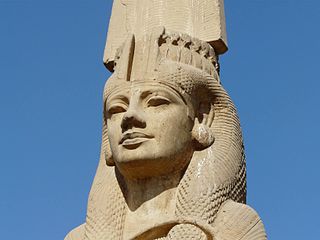
Meritamen was a daughter and later Great Royal Wife of Pharaoh Ramesses the Great.
The history of the Karnak Temple complex is largely the history of Thebes. The city does not appear to have been of any significance before the Eleventh Dynasty, and any temple building here would have been relatively small and unimportant, with any shrines being dedicated to the early god of Thebes, Montu. The earliest artifact found in the area of the temple is a small, eight-sided column from the Eleventh Dynasty, which mentions Amun-Re. The tomb of Intef II mentions a 'house of Amun', which implies some structure, whether a shrine or a small temple is unknown. The ancient name for Karnak, Ipet-Isut only really refers to the central core structures of the Precinct of Amun-Re, and was in use as early as the 11th Dynasty, again implying the presence of some form of temple before the Middle Kingdom expansion.

Meryatum was an Ancient Egyptian prince and High Priest of Re, the son of Pharaoh Ramesses II and Nefertari.

The High Priest of Amun or First Prophet of Amun was the highest-ranking priest in the priesthood of the ancient Egyptian god Amun. The first high priests of Amun appear in the New Kingdom of Egypt, at the beginning of the Eighteenth Dynasty.
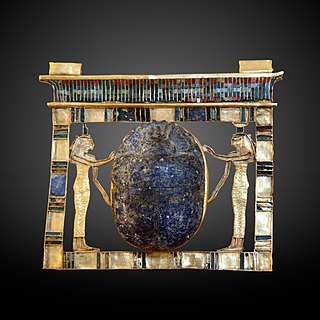
The Ancient Egyptian Noble Paser was vizier, in the reigns of Seti I and Ramesses II, during the 19th dynasty. He would later also become High Priest of Amun.

Theban Tomb TT2 is located in Deir el-Medina, part of the Theban Necropolis, on the west bank of the Nile, opposite to Luxor. It is the burial place of the Ancient Egyptian official, Khabekhnet, and his family. Khabekhnet was Servant in the Place of Truth, during the reign of Ramesses II.
The Theban Tomb TT31 is located in Sheikh Abd el-Qurna, part of the Theban Necropolis, on the west bank of the Nile, opposite to Luxor. It is the burial place of the Ancient Egyptian official, Khonsu who was First Prophet of Menkheperre, during the 19th Dynasty or 20th Dynasty.
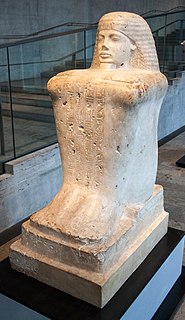
Bakenkhonsu was a High Priest of Amun in ancient Egypt during the reign of Pharaoh Ramesses II. Information about his life was found on the back of his block statue. The information on the statue provides details about the education of young Egyptian noblemen at that time and the career of priests.
Nebwenenef was High Priest of Amun at the beginning of the reign of Ramesses II during the 19th Dynasty. Prior to that, Nebwenenef had served as High Priest of Anhur and High Priest of Hathor during the reign of Seti I and possibly even earlier.
The Theban Tomb TT19 is located in Dra' Abu el-Naga', part of the Theban Necropolis, on the west bank of the Nile, opposite to Luxor. It is the burial place of the Ancient Egyptian Amenmose, who was the high priest of Amenhotep of the Forecourt during the early Nineteenth Dynasty.

Wenennefer was an ancient Egyptian High Priest of Osiris at Abydos, during the reign of pharaoh Ramesses II of the 19th Dynasty.
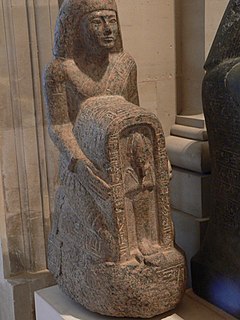
Yuyu was an ancient Egyptian High Priest of Osiris at Abydos, during the reign of pharaohs Ramesses II and possibly Merenptah of the 19th Dynasty.
Minmose was the High Priest of Anhur during the reign of Ramesses II
Mery was an ancient Egyptian High Priest of Osiris at Abydos, during the reign of pharaoh Sety I and Ramesses II of the 19th Dynasty.
The Theban Tomb C.7 is an Ancient Egyptian tomb in Thebes, Upper Egypt. It is located in Sheikh Abd el-Qurna, part of the Theban Necropolis on the west bank of the Nile opposite Luxor. It is the burial place of the Ancient Egyptian Horimose (Harmosi) who was the Head custodian of the treasury in the King's Mansion on the West of Thebes.